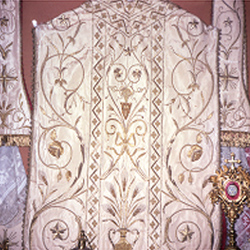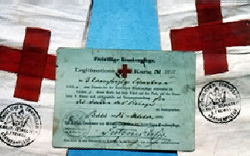- Jamaica
- Orleans; Rome
- Sevres
- St Thomas
Mission Search 1859-72
Elizabeth (Sr. M. Ignatius) Hayes, standing on the deck of the Atrato, thought that her mission in Jamaica would satisfy her yearning to serve God in the poor and under-privileged.
Jamaica

A woman, who knew Elizabeth well, looked at her with astonishment and asked, “Why are you throwing away your life in the West Indies?” The significance of these words – recorded by Elizabeth in her diary – is better understood if one realizes that this new missionary was a highly intelligent literary woman, well educated and very gifted.
Her missionary dream was to become – as she later described it – ‘a kind of slow torture process’. Instead of teaching the children of poor plantation workers of African origin, she was obliged to give lessons to daughters of wealthy plantation owners. While Elizabeth delighted in being ‘a Catholic, a religious, a Franciscan’, she struggled with the rigours of her French-orientated community who were trying to live ‘enclosure’ in a missionary situation that required adaptation and change. Hayes tried to cope with the oppressive heat of Kingston. She hoped to strengthen community life by speaking out for justice, peace and respect for the Franciscan Rule. Being woman of integrity, she had to be true to herself. In late 1862, having weighed up her options, her reasons for leaving Jamaica became clear and she requested permission to seek another mission where she could live her vowed life more meaningfully. Elizabeth felt unsure of where God was calling her. She asked herself, if it was nearby St. Thomas Island, with Mother Veronica Cordier who had left for France earlier or with Franciscans in Calais or Paris? After May 1863, Elizabeth with another sister set out for England; they proceeded onto London then on to France.
Orleans; Rome
Elizabeth Hayes and her Parisian Catholic friends were surrounded daily with Catholic foreign mission news. The Society of the Foreign Missions of Paris provided much mission content for publications. Yet Elizabeth knew her initial steps included engagement in local ministry, establishment of a convent and the training of young women for foreign missionary work. The Archbishop of Paris, Georges Darboy, provided suggestions but the offer made by the famous bishop of Orleans, Felix Dupanloup, pleased her more. In late July of 1864 Elizabeth was in Lyon collecting money for her Orleans foundation but then the bishop questioned the validity of her Glasgow Franciscan Constitutions.
In September Elizabeth travelled to Rome to seek definite clarification. Roman ecclesial authorities decided that a complete revision of the Constitutions was essential. Hayes accepted the challenge, aware that her French foundation was impossible without a pontifically approved Franciscan Rule and Constitutions. During the course of her lonely work, Hayes was requested by the Glasgow and Bayswater Franciscan Sisters to update and help seek approval for their respective Constitutions also.
Always an avid reader and very able with pen and ink, Elizabeth set about her task with confidence. When completed she found it difficult to hasten Roman ecclesiastical authorities for she was anxious to be back on a mission field again. Finally, being assured that Pope Pius IX would sign the approbation of the Rule and Constitutions soon, she left for France in August of 1866. In the following year her written work was printed and bound and due to her work Cardinal Barnabo signed a new Decree for the Glasgow Franciscans and a Rescript for the Bayswater Franciscans.
Sevres, Franco- Prussian War period
Elizabeth Hayes returned to Orleans only to discover that another religious community had commenced an educational ministry there, so she resurrected a former plan for Sèvres with the Bishop of Versailles, who gave her ‘a house, chapel and chaplain’ with his blessing to establish a school for boarders and a novitiate.

On 8 December, the feast of the Immaculate Conception of the Blessed Virgin Mary, Mass was celebrated in Sèvres’ convent chapel. By the 15th, Monsignor Talbot at the Vatican replied in length to Hayes’ letter from ‘13 Bellevue Avenue, Sèvres, près Paris’. Elizabeth had gathered several companions as foundation members of her new community. The mission needed financial assistance so Hon. Fanny Montgomery collected funds and involved Talbot in the project. Her proximity to Paris, with Montgomery’s presence there, provided her with opportunity to observe French Catholic periodicals, to read publications from outstanding Catholic writers and to be aware of the irreligious press that France, like other countries, was producing. Hayes and her community flourished for over three years until the outbreak of the Franco-Prussian war when the convent was forced to close and the community was disbanded.
Elizabeth, accompanied by three English-born companions, community member Sr. Mary Clare Peet, Hon. Mrs. Montgomery and Rosalie, a young orphan, set out toward the French-German border. Railway authorizations testify that the English group was permitted to travel first to Nancy and then Saarbrüken.
The horrific conditions under which travellers moved were described by the former Vicar, Butler of Wantage, who was in Germany and France at this time. Butler wrote regularly to his wife while working in Cologne, Arlon, around Sedan and in Saarbrüken on a Red Cross commission. Elizabeth was also working for the Red Cross and nursed wounded French soldiers.

They numbered many, many thousands in hospitals, formerly large chateaux, castles or convents, or in village hotels and homes spread around battlefields. Hayes and her companions, who ministered just outside Berlin, made their way to the capital where their ‘Accreditation for Voluntary Care of the Sick’ was signed on 24 October. In January 1871 they were given passports, signed by Lord Augustus Loftus, as British subjects travelling on the continent.
The exact movements of Elizabeth Hayes and her group in Germany and France for many months remain obscure but it is confirmed that other English groups, including doctors, nurses, religious Sisters and Red Cross volunteers, helped the many wounded soldiers. Elizabeth and Montgomery observed people and events during the outbreak of the Kulturkampf (religious persecution) and they witnessed the necessity for and power of the Catholic press. It appears that Franciscanism and literary interests guided some of Montgomery and Hayes’ activities in 1871. Both women were committed to Franciscanism and writing while Montgomery’s wealth and influence, plus the presence of Sisters in Franciscan habits, facilitated their common interests. Wherever Elizabeth and her companions moved in 1871, they obviously kept away from Paris where the Commune brought about the massacre of thousands of citizens and was directly responsible for the deaths of Archbishop Darboy and five Jesuits.
St Thomas (West Indies)
Events of this historic period were profoundly influential; for Elizabeth in early 1872, it was time to follow her missionary vision again. She accepted the invitation of a Belgian Redemptorist, Fr. Louis de Buggenoms, to go to the West Indies again, this time to the Island of St. Thomas. Elizabeth Hayes and Peet arrived in the port of St. Thomas where passengers were quarantined; unfortunately Hayes was given a room in which the former occupant had died from yellow fever and she became very ill. Conflicting comments about numerous difficulties at the mission have circulated over the years but the outcome at the time was that Elizabeth and Clare Peet withdrew and headed for New York.
